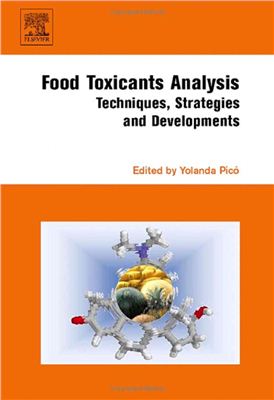Elsevier. 2007. 755 p.
Food Toxicants Analysis covers different aspects from the field of analytical food toxicology including emerging analytical techniques and applications to detect food allergens, genetically modified organisms, and novel ingredients (including those of functional foods). Focus will be on natural toxins in food plants and animals, cancer modulating substances, microbial toxins in foods (algal, fungal, and bacterial) and all groups of contaminants (i.e., pesticides), persistent organic pollutants, metals, packaging materials, hormones and animal drug residues. The first section describes the current status of the regulatory framework, including the key principles of the EU food law, food safety, and the main mechanisms of enforcement. The second section addresses validation and quality assurance in food toxicants analysis and comprises a general discussion on the use of risk analysis in establishing priorities, the selection and quality control of available analytical techniques. The third section addresses new issues in food toxicant analysis including food allergens and genetically modified organisms (GMOs). The fourth section covers the analysis of organic food toxicants.
Contents
The inteational regulation of chemical toxicants in food. Codex Alimentarius
Different legislations on toxicants in foodstuffs
Risk assessment of food additives and contaminants
Quality Assurance
Immunoassays
Polymerase chain reaction (PCR)
Analysis of food allergens. Practical applications
Sampling, detection, identification and quantification of genetically modified organisms (GMOs)
Extraction procedures
Clean-up and fractionation methods
Automated clean up techniques
Gas chromatography–mass spectrometry (GC–MS)
Liquid chromatography with conventional detection
Liquid chromatography-mass spectrometry
Capillary electrophoresis
Sensor, biosensors and MIP based sensors
Atomic Absorption Spectroscopy
Electrochemical stripping analysis of trace and ultra-trace concentrations of toxic metals and metalloids in foods and beverages
Inductively coupled plasma mass spectrometry
Food Toxicants Analysis covers different aspects from the field of analytical food toxicology including emerging analytical techniques and applications to detect food allergens, genetically modified organisms, and novel ingredients (including those of functional foods). Focus will be on natural toxins in food plants and animals, cancer modulating substances, microbial toxins in foods (algal, fungal, and bacterial) and all groups of contaminants (i.e., pesticides), persistent organic pollutants, metals, packaging materials, hormones and animal drug residues. The first section describes the current status of the regulatory framework, including the key principles of the EU food law, food safety, and the main mechanisms of enforcement. The second section addresses validation and quality assurance in food toxicants analysis and comprises a general discussion on the use of risk analysis in establishing priorities, the selection and quality control of available analytical techniques. The third section addresses new issues in food toxicant analysis including food allergens and genetically modified organisms (GMOs). The fourth section covers the analysis of organic food toxicants.
Contents
The inteational regulation of chemical toxicants in food. Codex Alimentarius
Different legislations on toxicants in foodstuffs
Risk assessment of food additives and contaminants
Quality Assurance
Immunoassays
Polymerase chain reaction (PCR)
Analysis of food allergens. Practical applications
Sampling, detection, identification and quantification of genetically modified organisms (GMOs)
Extraction procedures
Clean-up and fractionation methods
Automated clean up techniques
Gas chromatography–mass spectrometry (GC–MS)
Liquid chromatography with conventional detection
Liquid chromatography-mass spectrometry
Capillary electrophoresis
Sensor, biosensors and MIP based sensors
Atomic Absorption Spectroscopy
Electrochemical stripping analysis of trace and ultra-trace concentrations of toxic metals and metalloids in foods and beverages
Inductively coupled plasma mass spectrometry

